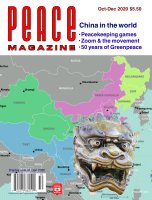
Peace Magazine Oct-Dec 2020, page 12. Some rights reserved.
Comments are enabled for this article. If you would like to view or add comments, please follow this link.
Search for other articles by Adele Buckley here
In the Arctic, shortened shipping routes, hydrocarbon resources, mining, fisheries, and tourism already present economic opportunities, which will expand exponentially as the Arctic ice disappears.
Strategic planning for China’s participation in opening of the Arctic has been a priority of the Chinese government since early in the 21st century. Well before 2010, China was petitioning for observer status at the Arctic Council.
This article reviews some highlights of China’s entry into the Arctic.
2004 and ongoing: China has established land-based research stations in Svalbard, Iceland1 and Greenland.2 Arctic research began at least as early as the 1990s, before permanent bases were established.
2011: The Chinese icebreaker Xue Long (Snow Dragon) made a 2-way crossing of the Arctic, arriving in Iceland via the Northern Sea Route in 2011, and returning via the central Arctic near the North Pole. The stated purpose: scientific research. The quiet preparation beforehand:3 many years. On its 7th Arctic voyage, Xue Long traversed Canada’s Northwest Passage. These research programs could produce maps, charts, biological population surveys; there is no information on whether China’s polar research is shared with other Arctic nations.
In Greenland, China has an operating iron ore mine, and another that can extract rare earth minerals, increasing China’s near-monopoly, globally, of key rare-earth elements essential to the global communications industry, e.g. cell phones. In recent years, China has negotiated with Greenland to be the prime supplier of an airport, but was rejected because of the financial terms, and the potential interference with Greenland’s sovereignty.
2013: China was granted observer status at the Arctic Council4 (with five other nations).
2016: While China has established a significant presence in the geographic European and North American Arctic regions, its main economic and political interests are with the Russian Arctic5 including its Asian flanks. China seeks partnership with Russia for developing hydrocarbons, and is, for example, a partner with Russia for the Yamal6 liquified natural gas plant in northern Siberia (and in 2020 the Arctic LNG 2 project was agreed).
2018: In January, China’s white paper on Arctic policy was issued, startling the international community with its self-proclaimed status as a “near-Arctic” nation, and proclaiming its intent for continuing scientific research and peaceful economic cooperation. The necessity of cooperation in the North’s harsh conditions is well known to Arctic nations.
David C. Wright draws attention to China’s hawkish voices in “The Dragon and Great Power Rivalry on the Top of the World.”7 A scholar from its Naval Military Academic Institute writes “If our navy can effectively take advantage of the space and strategic passageways of the Arctic, then in the future it can pivot around [from the Arctic Ocean towards] the great oceans and deal with threats coming from any direction…”
2020: China already has submarines equipped with nuclear weapons, though it has yet to produce submarines hardened for Arctic conditions. Shandong, a company controlled by the Chinese government, is currently negotiating with the Government of Canada to buy Hope Bay gold mine8, which has access to the Arctic shore. China’s foothold in Canada could be a major link in its intended Polar Silk Road. If executed, this deal has potential to allow ships of the Chinese navy (PLAN) to use, and possibly to inhibit access to Canada’s Northwest Passage.
The first Chinese-built icebreaker Xue Long 2, having already visited the Antarctic, left9 its home port of Shanghai in July 2020 on a 12,000-nautical-mile voyage—its first ever to the Arctic.
Perhaps one interesting development is China’s commercial shipments in the summer of 2020, both ways, via Russia’s Northern Sea Route, thus gaining the advantage of a much shorter trip, and reaping the economic benefits to be gained by regular use of the route. While it is premature to say that the Polar Silk Road is open, this is a serious move toward that goal.
With similar economic goals, China is equally engaged in the Antarctic, but close comparison to the Arctic is not useful, because of the very different geopolitical landscape. There is abundant evidence that China intends to be a major player in the polar regions, to make investments favourable to itself, and potentially would protect its interests with a military presence. The policy and security implication for the Arctic nations is to be determined.
Adele Buckley is a physicist, aerospace engineer and environmental scientist, past Chair of Canadian Pugwash, and member of the international Pugwash Council.
1 www.xinhuanet.com/english/2018-10/19/c_137542493.htm Oct 19, 2018 The China-Iceland Arctic Science Observatory was inaugurated and officially began operation in northern Iceland.
2 www.arctictoday.com/china-us-strategic-designs… In Svalbard – the Yellow River Station was established in 2004. One or more Greenland research stations are being developed.
3 Since the early 1990s, Chinese scholars have conducted Arctic and Antarctic expeditions aboard research icebreaker Xue Long, built for China in Ukraine, www.thearcticinstitute.org/china-arctic…
4 arctic-council.org/index.php.en/about-us/arctic-council/observers
5 Canada Institute interview with Stephanie Pezard: Emerging Challenges and Strategic Competition in the Arctic, Aug 13 2020. cdainstitute.ca/cda-institute-interview-with-stephanie-pezard-emerging-challenges-strategic-competition-in-the-arctic
7 David Curtis Wright, September 2018 for Canadian Global Affairs Institute, quoting Yang Zhirong1 (2015), a scholar at the Naval Military Academic Research Institute46, Beijing, in “The Dragon and Great Power Rivalry at the Top of the World: China’s Hawkish, Revisionist Voices ….”
8 www.arctictoday.com/chinas-new-icebreaker-sets-course-for-its-first-arctic-voyage

Peace Magazine Oct-Dec 2020, page 12. Some rights reserved.
Comments are enabled for this article. If you would like to view or add comments, please follow this link.
Search for other articles by Adele Buckley here